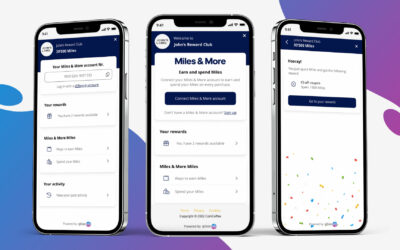Do You Know if Your Loyalty Program Sucks?
A study from KPMG showed that 96% of customers think that brands should rethink their loyalty efforts. Even worse, 78% of these customers said that they would switch to a brand for a better loyalty program. This culminates in the fact that 69% of customers are not active after signing up, since they think it’s too hard to earn attractive rewards. In a nutshell, customers think that a lot of loyalty programs suck.
Why should we care? 81% of customers say that being a member of a loyalty program encourages them to spend more with a company. And this is only one of many advantages of engaging customers and creating loyalty. That being said, you can’t afford that your loyalty program sucks. So the first question to ask yourself is, does my loyalty program suck? Be honest with yourself and don’t be afraid of the answer, you’re not alone and there are many solutions.
What makes my loyalty program suck?
Have you ever joined a loyalty program purely out of convenience but after a few purchases you start to realize that you are not even earning enough points to obtain the rewards you really want? If the answer is yes, then you have already experienced one of the reasons why many loyalty programs fail to engage their users.
In fact, Smile.io reported that the top consumer frustrations with loyalty programs included: unappealing rewards, frustrating signup process, confusing redemption process, and difficulty tracking points.
The process of earning points and accumulating enough to redeem them for an awesome reward is fundamental to driving more engagement and generally improving customer satisfaction. It is clear that users put a lot of weight on the reward and redemption process with more than 40% of users saying wrongful redemption would negatively impact their interactions with a brand and would lead them to make disparaging online posts about the brand (Kelton).
How do I know if my loyalty program sucks?
Based on what you have read up to now you know that sucking is not an option. Now the next question is, how do we find out if our loyalty programs are working or not? Here is a checklist of metrics that can be used to evaluate your loyalty program and develop an idea of whether your loyalty program is making your customers happy. This is not a final checklist and of course, can change depending on the loyalty program to be evaluated:
- Conversion rate customers to members = members rewarded with points for the first time/number of customers that completed a purchase (the higher the better)
- Monthly active members = number of active members per month / total number of members (the higher the better)
- Redemption rate = Total number of points spent until expiration date X / Points earned at issuing date (the higher the better)
- Average time to first redemption = Average price in points for any redemption / Average points earned per day per member (shorter duration is better)
- Average life of a point = Date of points acquisition – Date of points redemption (the shorter the better)
- Customer vs. Member Purchase Size = average purchase size per member / average purchase size per customer (ratio > 100% means member spends more than customer)
- Customer vs. Member Purchase Frequency = average purchase frequency per member / average purchase frequency per customer (ratio > 100% means member purchases more frequently than customer)
- Customer vs. Member Revenue Generated = Purchase Frequency of member * Purchase Size of member / Purchase Frequency of customer * Purchase Size of the customer (ratio > 100% means member generates more revenue than customer)
- Customer vs. Member Profit = Average customer profit generated – Average member profit generated / Margins generated (higher member profit = better loyalty indicator)
- Loyalty program penetration of revenues = Total revenue generated from main channels in QX – Total revenue generated from the loyalty program in QX (depends on priorities – higher loyalty program revenue is a better loyalty indicator)
- Loyalty program penetration of profits = Total net profits generated from main channels in QX – Total net profits generated from the loyalty program in QX (depends on priorities – higher loyalty profits is a better loyalty indicator)
- Member tenure = Number of members signing up to the program / Number of members exiting the program * 100 (the higher the better)
Evaluate how your loyalty program is doing based on these metrics and see a much more successful improvement in your program. Of course, not all of these metrics will perfectly represent how your loyalty program is doing, but they should at least provide a good idea of what direction to take next.
Why shouldn’t my loyalty program suck?
The experiences your brand provides for the users are just as important as the product, with many experience-driven businesses reporting between 1.6x-1.9x higher year-on-year growth in customer retention, repeat purchase rates, customer lifetime value, and average order value, in comparison to other brands (Iperceptions).
This fits perfectly with what other brands are saying about loyalty, in fact “51% of businesses with premium loyalty programs consider program members to be at least 4x as valuable as non-members”. Similarly Clarus Commerce, also reported that 94% of premium loyalty members shop more frequently at that program’s retailer than non-members.
Enhancing your loyalty program is not just a short-term cash grab but if handled and implemented well, it can transform into a new channel of revenue for your brand, given that users seek to use it. All in all the benefits are long-lasting and multi-faceted, even going as far as reducing the customer acquisition cost for brands, as was shown by Brand Keys in their report: “A customer loyalty increase of 7% can boost lifetime profits per customer by as much as 85%, and a loyalty increase of 3% can correlate to a 10% cost reduction”.
If your brand takes the time to implement rewarding features, benefits, and options for the users as well as tending to different aspects, such as points accumulation and improving user experience; Then users will automatically take more time to engage with your program as well as your brand. Simply because the experience is worth it and appealing to a larger audience!
Key Takeaways (TL:DR)
- Loyalty programs tend to fail due to their lack of rewarding options and their failure to engage users properly. In fact, Smile.io demonstrated that the top user frustrations with loyalty programs included: unappealing rewards, a frustrating signup process, a confusing redemption process, and difficult tracking points.
- There are various metrics that should be used by your brand to more accurately evaluate whether your loyalty program is succeeding and growing in the right aspects. Some of the ones observed included: Conversion rate from customers to members, Monthly active members, Redemption rate, Average life of a point, and many more!
- Creating and maintaining a successful loyalty program is difficult but can provide your brand with long-lasting benefits, such as a cost reduction of about 10% and a boost in lifetime profits per customer by as much as 85% with only a 7% customer loyalty increase, as indicated by Brand Keys.
qiibee: Access world-class brands your customers love.
Most Recent Posts
Your Miles, Your Voice: Shape the Future of Shopping!
Make a DifferenceAre you eager to make an impact with your insights and earn up to 200 Miles in...
Breaking the Mold: Why qiibee’s Miles & More Loyalty App is Revolutionizing Shopify Loyalty Programs
In the realm of Shopify loyalty apps, the traditional approach often revolves around creating an...
Introducing qiibee: Miles & More Loyalty App for Shopify – Elevate Your Customer Loyalty Experience!
Attention Shopify Merchants! The wait is over! We are thrilled to announce the launch of the...



